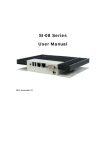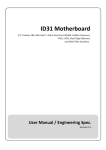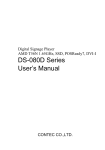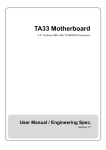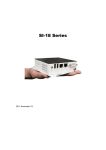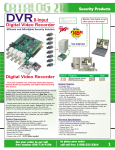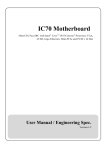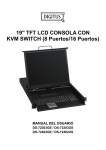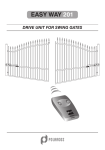Download User`s Manual
Transcript
Digital Signage OPS Module User’s Manual The digital signage display Optional Pluggable Specification (OPS) which enables a standard and easier integration of a digital signage computing system or a pluggable module into the display panel. User Guide Version 1.0 WinMate Communication INC. Revision History Version Date 1.0 2011.08.26 Note Author Henry Hsu Package List Before using this Digital Signage Evaluation Kit, please make sure that all the items listed below are present in your package 1. Box (Packaging) 2. 1 x Pluggable Module 3. 1 x User’s Manual & Driver DVD Make sure that all of the items listed above are present. Do not attempt to apply power to the system if there is damage to any of its components. 2 Digital Signage Pluggable Module User’s Manual FCC Statement This device complies with part 15 FCC rules. Operation is subject to the following two conditions: • This device may not cause harmful interference. • This device must accept any interference received including interference that may cause undesired operation. This equipment has been tested and found to comply with the limits for a class "a" digital device, pursuant to part 15 of the FCC rules. These limits are designed to provide reasonable protection against harmful interference when the equipment is operated in a commercial environment. This equipment generates, uses, and can radiate radio frequency energy and, if not installed and used in accordance with the instruction manual, may cause harmful interference to radio communications. Operation of this equipment in a residential area is likely to cause harmful interference in which case the user will be required to correct the interference at him own expense. Copyright Notice ALL RIGHTS RESERVED. No part of this document may be reproduced, copied, translated, or transmitted in any form or by any means, electronic or mechanical, for any purpose, without the prior written permission of the original manufacturer. Trademark Acknowledgement Brand and product names are trademarks or registered trademarks of their respective owners. 3 Digital Signage Pluggable Module User’s Manual Disclaimer We reserve the right to make changes, without notice, to any product, including circuits and/or software described or contained in this manual in order to improve design and/or performance. We assume no responsibility or liability for the use of the described product(s), conveys no license or title under any patent, copyright, or masks work rights to these products, and makes no representations or warranties that these products are free from patent, copyright, or mask work right infringement, unless otherwise specified. Applications that are described in this manual are for illustration purposes only. We Communication Inc. make no representation or warranty that such application will be suitable for the specified use without further testing or modification. Warranty We warrant that each of its products will be free from material and workmanship defects for a period of one year from the invoice date. If the customer discovers a defect, We will, at its option, repair or replace the defective product at no charge to the customer, provided it is returned during the warranty period of one year, with transportation charges prepaid. The returned product must be properly packaged in it’s original packaging to obtain warranty service. If the serial number and the product shipping data differ by over 30 days, the in-warranty service will be made according to the shipping date. In the serial numbers the third and fourth two digits give the year of manufacture, and the fifth digit means the month (e. g., with A for October, B for November and C for December). For example, the serial number 1W11Axxxxxxxx means October of year 2011. 4 Digital Signage Pluggable Module User’s Manual Customer Service We provide service guide for any problem as follow steps: First, contact with your distributor, sales representative, or our customer service center for technical support if you need additional assistance. You may have the following information ready before you call: • Product serial number • Peripheral attachments • Software (OS, version, application software, etc.) • Description of complete problem • The exact wording of any error messages In addition, free technical support is available from our engineers every business day. We are always ready to give advice on application requirements or specific information on the installation and operation of any of our products. Please do not hesitate to call or e-mail us. Safety Precautions • Warning! Always completely disconnect the power cord from your chassis whenever you work with the hardware. Do not make connections while the power is on. Sensitive electronic components can be damaged by sudden power surges. Only experienced electronics personnel should open the Player chassis. • Caution! Always ground yourself to remove any static charge before touching the CPU card. Modern electronic devices are very sensitive to static electric charges. As a safety precaution, use a grounding wrist strap at all times. Place all electronic components in a static-dissipative surface or static-shielded bag when they are not in the chassis. 5 Digital Signage Pluggable Module User’s Manual Safety and Warranty 1. Please disconnect this equipment from any AC outlet before cleaning. Do not use liquid or spray detergents for cleaning. Use a damp cloth. 2. For pluggable equipment, the power outlet must be installed near the equipment and must be easily accessible. 3. Keep this equipment away from humidity. 4. Put this equipment on a reliable surface during installation. Dropping it or letting it fall could cause damage. 5. The openings on the enclosure are for air convection. Protect the equipment from overheating. DO NOT COVER THE OPENINGS. 6. Make sure the voltage of the power source is correct before connecting the equipment to the power outlet. 7. All cautions and warnings on the equipment should be noted. 8. If the equipment is not used for a long time, disconnect it from the power source to avoid damage by transient over-voltage. 9. Never pour any liquid into an opening. This could cause fire or electrical shock. 10. Never open the equipment. For safety reasons, only qualified service personnel should open the equipment. 11. If any of the following situations arises, get the equipment checked by service personnel: A. Liquid has penetrated into the equipment. B. The equipment has been exposed to moisture. C. The equipment does not work well, or you cannot get it to work according to the user’s manual. D. The equipment has been dropped and damaged. E. The equipment has obvious signs of breakage. 12. Do not leave this equipment in an uncontrolled environment where the storage temperature is below -20° C (-4°F) or above 60° C (140° F). It may damage the equipment. 6 Digital Signage Pluggable Module User’s Manual Table of Contents 1. Introduction ............................................................................................................................ 8 1.1 Reference Solution Lineup with Intel Platform ...............................................8 1.2 Reference Documents .....................................................................................9 1.3 Terms and Abbreviation ..................................................................................9 2. Mechanical Assembly............................................................................................................ 10 2.1 Package Information.....................................................................................................10 2.2 The Pluggable Module ..................................................................................................10 2.3 Mechanical Specifications .............................................................................................12 3. Thermal Specifications.......................................................................................................... 19 3.1 Thermal Management for the Pluggable Module .........................................................19 3.2 Thermal Management in the Reference Display Panel System ....................................21 4. Mechanical Design ................................................................................................................ 23 4.1 The Prototype ................................................................................................................23 5. BIOS Setting .......................................................................................................................... 25 5.1 Advanced Setting ..........................................................................................................26 5.3 Boot 5.4 Security 5.5 Save & Exit.....................................................................................................................54 7 Digital Signage Pluggable Module User’s Manual 1. Introduction 1.1 Reference Solution Lineup with Intel Platform The purpose of this document is to describe the thermal design requirements of the Digital Signage Pluggable Module. This module is based on the Intel® CoreTM i5-2515E processor with Mobile Intel® 6 Series Express Chipset (QM67) platform and also future products. The Pluggable Module is targeted to provide an interchangeable solution to the digital signage media players with compatible connector. This document provides the module form factor, connector specification, reference thermal solution, and boundary conditions in order to ensure the functionally of the module in all compatible display panel system. The Digital Signage Pluggable Module platform has two reference solutions, as listed in the table below: Digital Signage Pluggable Module Type 1 Intel® CoreTM Processor i5-2515E CPU TDP(W) Thermal Solution 35W Active System Dimension (mm) 200x119x30 8 Digital Signage Pluggable Module User’s Manual 1.2 Reference Documents Document Document No./Location Digital Signage Open Pluggable Specification 324427 JAE TX24/TX25 connector product brief http://jae-connectors.com/en/pdf/2008-40TX24TX25.pdf JAE plug connector details and drawing http://jaeconnectors.com/en/product_en.cfm?l_code=EN&s eries_code=TX24/TX25&product_number=TX2580P-LT-H1E JAE receptacle connector details and drawing http://jaeconnectors.com/en/product_en.cfm?l_code=EN&s eries_code=TX24/TX25&product_number=TX2480R-LT-H1E 1.3 Terms and Abbreviation Term DIMM EPIC Description FAR OPS SATA SSD USB Dual In-line Memory Module Embedded Platform for Industrial Computing form factor 165 mm x 115 mm Free Area Ratio Open Pluggable Specification Serial ATA Solid State Drive Universal Serial Bus VESA Wifi Wimax Video Electronics Standards Association Wireless IEEE 802.11 technology Worldwide Interoperability for Microwave Access 9 Digital Signage Pluggable Module User’s Manual 2. Mechanical Assembly 2.1 Package Information The Intel® CoreTM i5-2515E processor come in BGA packaging with package size 34x28 mm. The QM67 chipset is a Platform Controller Hub (PCH) that comes in an FCBGA package, which consists of a silicon die mounted face down on an organic substrate populated with solder balls on the bottom side. The package size of the PCH is 25x27 mm. 2.2 The Pluggable Module Figure 1 shows the features overview of the Pluggable Module. The module front panel consists of the antenna slots, power/reset buttons, audio jacks, RJ45 connector, a DSP port, and 2xUSB ports. The sides of the module consist of 4 guide holes which, when come into contact with the locking pins on the guide rail, lock the module during docking/undocking. Figure 2 shows the dimensions of the Pluggable Module. The overall dimension of the module including the mounting frame is 200mm x 119mm x 30mm. Figure 2 also shows the location of the front panel screw holes as well as the security lock. 10 Digital Signage Pluggable Module User’s Manual Figure 1. Figure 2. The Pluggable Module Dimensions of the Pluggable Module 11 Digital Signage Pluggable Module User’s Manual 2.3 Mechanical Specifications Figure 3 shows the Pluggable Module docked at a display panel system. In this reference design, the module is docked and undocked in vertical direction. There are two system fans that drive room temperature air to enter the system through the vent holes at the back cover. Notice that in Figure the system fans are inclined at an angle to the vertical direction in order to align with the shape of the back cover. Figure 3. Pluggable Module Docked in the Reference Display Panel Display Panel FRONT Pluggable Module BOTTOM Ext ract ion Fans Pluggable Module BACK TOP Figure 4 illustrates the airflow path to the Pluggable Module. Air at room temperature enters the system through the back vent holes and exit at the top through the extraction fans. In the passive heatsink module, air flows through the heatsink fins and carries away the heat. In the active heatsink module, air is forced through the fins by the fan so that higher cooling rate is achieved. The details inside the Pluggable Module are shown in Figure 5. The top side of the PCB resides the CPU and the chipset. The heatsink comes into contact with these components so that heat is conducted to the heatsink and cooled by air movement through the fins. The WiFi card and memory module are located at the bottom of the PCB. 12 Digital Signage Pluggable Module User’s Manual Figure 4. Airflow to the Pluggable Module 13 Digital Signage Pluggable Module User’s Manual Figure 5. Exploded View of the Pluggable Module 14 Digital Signage Pluggable Module User’s Manual Figure 6. The Guide Rail Mechanism for the Pluggable Module The Pluggable Module relies on a pair of guide rails for docking and undocking so that the plug connector at the back of the module can mate seamlessly with the receptacle on the docking board. Figure 6 shows the docking process as the module slides through the guide rails. There are two lock pins on each side of the guide rail which serve as the locking mechanism to the module when they come into contact with the lock holes on the Pluggable Module. Figure 7 shows the location of the lock holes on the module and Figure 8 shows the detailed dimensions of one of the guide rails. 15 Digital Signage Pluggable Module User’s Manual Figure 7. Location of Lock Hole on the Pluggable Module Figure 8. Dimensions of the Guide Rail 16 Digital Signage Pluggable Module User’s Manual Figure9 shows the cross-section of a display panel system when the Pluggable Module is plugged in. Noticing that in this reference design there is 10.4 mm clearance between the Pluggable Module and the display panel in order to avoid heating from the panel. Figure 9. Cross-section Showing Recommended Clearance between Pluggable Module and the Display Panel Figure 10 shows the full platform dimension of the Digital Signage Pluggable Module display system. Figure 11 shows the dimension of the docking board in the system as well as the VESA mounting holes. 17 Digital Signage Pluggable Module User’s Manual Figure 10. Platform Dimension for a Reference Display Panel System Figure 11. Location of the VESA Mount on the Display Panel 18 Digital Signage Pluggable Module User’s Manual 3. Thermal Specifications 3.1 Thermal Management for the Pluggable Module This section describes a wind tunnel test to quantify the thermal performance of the Pluggable Module. Figure 12 shows a thermal model of an arbitrary wind tunnel, where the Pluggable Module is situated at the front of the tunnel. Air flows in from the top grille with specified Free Area Ratio (FAR) so that air at room temperature enters the heatsink of the module. In this test, the FAR is set at 0.6 for reference. The outflow is controlled to obtain the desired airflow flowing through the module. It is required that module be designed to pass all component thermal specifications in this test setup with ambient temperature at 54°C and airflow speed of 0.7m/s immediately downstream of the module. All Pluggable Modules must be designed to pass this temperature and airflow requirement to ensure the module ingredients comply with thermal specification. Figure 3 shows the top view of the wind tunnel test and the location of the imaginary plane 3 mm downstream from the module outlet. Figure 12. Wind Tunnel Test for the Pluggable Module 19 Digital Signage Pluggable Module User’s Manual Figure 3. Airflow Speed Requirement Downstream of the Pluggable Module in Wind Tunnel Test 20 Digital Signage Pluggable Module User’s Manual 3.2 Thermal Management in the Reference Display Panel System The Pluggable Module relies on airflow from the system fans to achieve its cooling target. Figure 4 shows that in this reference design there are two 70x70 mm fans at the back panel to extract hot air from the system. There is also a 50x50 mm fan at the front panel to provide fresh air to the internal components such as power supply unit. The back cover of the display panel should have vent holes with FAR > 0.6 to provide sufficient airflow to the module. Figure 4. System Fans and Ventilation Grille on the Display Back Panel 21 Digital Signage Pluggable Module User’s Manual On the Pluggable Module, it is recommended that some vent holes be opened at the back so that hot air can escape more easily from the module. Figure 15 shows that the FAR in on both sides of the module back panel should be greater than 0.25. Figure 15. Vent Holes at the Pluggable Module Back Panel 22 Digital Signage Pluggable Module User’s Manual 4. Mechanical Design 4.1 The Prototype The digital signage OPS prototype is based on a 32” display panel with the functional blocks illustrated in Figure 16. It is mainly a 3-board partitioning design consisting of the pluggable module, docking board and the panel control board. Figure 16. Display Panel Rear View - Internal 23 Digital Signage Pluggable Module User’s Manual 4.2 Pluggable Board Reference Design Features In this reference design, the pluggable prototype board is based on the Intel® Core™ i7 Mobile processor and Mobile Intel® QM57 Express chipset platform. Table 1. Reference Design Board Features OMIS-OPS (Sandy Bridge Platform - Optional Pluggable Specification) SPEC. EPIC(165mm x 115mm) MB Form Factor Socket Intel® i7/i5 processor (Sandy Bridge Core) Type BGA CPU CPU Power i5-2515E (35W) Consumption Chipset PCH Intel 6 series Chipset (QM67) Integrated Gfx Gen 6, supports DirectX 10.1 and Graphic GPU Core OpenGL 3.0 Channel Dual-Channel Mode Type 1 x DDR3 SO-DIMM Socket Memory DDR 1066/1333MHz Max Memory 4GB Audio chipset Realtek RTL886 Display Out 1 x HDMI (by HDMI connector) VGA/COM Port 1 x Dual RS-232 (by Display port connector) USB Port 2 x USB2.0 Port Ethernet Port 1x RJ-45 LAN Port Gigabit Ethernet External I/O Audio 1x Line-In, 1x Line-Out 1 x Power On Button 1 x Reset button Antenna Antenna x 2 VGA 1 x VGA (2x4-pin) 2.0mm pitch wafer-header Internal I/O Fan 1 x Fan (1x3-pin), one fan (1x3-pin) reserve SIM card 1 x SIM card slot (for mini PCIe 3G module) 1 x SATA Ports (option of 2.5" HDD or SSD Storage Internal mounting) features WiFi Module 1 x Mini PCIe slot (for wireless module) Display Interfaces HDMI/DVI UART 1set RX/TX signals driven at 3.3V Audio 1 channel audio out L/R USB 3 x USB2.0 + 2 USB3.0 (reserve) Pluggable DC IN +12V~+19V at recommended 4A max Connector Power current rating Interface *Pluggable board Power Status indicator *Display panel IR remote control power button Control signals *Pluggable board detect *HDMI CEC Mechanical PCB placement Remark LAN chipset: Intel 82579LM Molex-53398-0310 Recommended 500mA for each pin, total 8pins, Follow IQWB-OPS 24 Digital Signage Pluggable Module User’s Manual 5. BIOS Setting Your computer comes with a hardware configuration program which called BIOS Setup that allows you to view and set up the system parameters. The BIOS (Basic Input / Output System) is a layer of the software called ‘firmware’ which translates instructions from software (such as the operating system) into instructions that allow the computer hardware to understand the software programs. The BIOS settings also identify installed devices and establish many special features. ENTERING BIOS SETUP You can access the BIOS program just after you turn on your computer. Just press the “DEL” key when the following prompt appears: Press <DEL> to enter Setup. When you press <DEL> to enter the BIOS Setup image, the system interrupts the Power-On SelfTest (POST). When you first enter the BIOS Setup Utility, you will enter the Main setup image. You can always return to the Main setup image by selecting the Main tab. There are two Main Setup options. They are described in this section. The Main BIOS Setup image is shown as below. 25 Digital Signage Pluggable Module User’s Manual The Main BIOS setup image has two main frames. The left frame displays all the options that can be configured. Grayed-out options cannot be configured. On the contrary, options in blue can be configured. The right frame displays the key legend. Above the key legend is an area reserved for a text message. When an option is selected in the left frame, it is highlighted in white. Often a text message will accompany it. 5.1 Advanced Setting Legacy OpROM SETTING DESCRIPTION Disabled Use this setting to ignore all PXE Option ROMs. Enabled Use this setting to load PXE Option ROMs. To limit the PXE support to particular devices, use the function Use device for PXE. Default: Disabled Launch Storage OpROM SETTING DESCRIPTION Disabled Use this setting to ignore all PXE Option ROMs. Enabled Use this setting to specify that legacy PCI option ROMs for PCI storage devices are to be loaded and executed, if found. Typical examples of PCI storage devices include SCSI or similar devices. Default: Enabled 26 Digital Signage Pluggable Module User’s Manual PCI ROM Priority Selects the PCI Option ROM to launch in case Multiple Option ROMs (Legacy ROM and EFI Compatible ROM) are present. PCI Latency Timer Use this function to select the number of PCI bus clocks to be used for the PCI latency timer. 27 Digital Signage Pluggable Module User’s Manual SETTING DESCRIPTION 32 PCI Bus Clocks Use this setting to program the PCI latency timer to 32 PCI bus clocks. 64 PCI Bus Clocks Use this setting to program the PCI latency timer to 64 PCI bus clocks. 96 PCI Bus Clocks Use this setting to program the PCI latency timer to 96 PCI bus clocks. 128 PCI Bus Clocks Use this setting to program the PCI latency timer to 128 PCI bus clocks. 160 PCI Bus Clocks Use this setting to program the PCI latency timer to 160 PCI bus clocks. 192 PCI Bus Clocks Use this setting to program the PCI latency timer to 192 PCI bus clocks. 224 PCI Bus Clocks Use this setting to program the PCI latency timer to 224 PCI bus clocks. 248 PCI Bus Clocks Use this setting to program the PCI latency timer to 248 PCI bus clocks. Default: 32 PCI Bus Clocks VGA Palette Snoop This filed controls the ability of a primary PCI VGA controller to share a common palette (when a snoop write cycles) with an ISA video card. Enables or Disables VGA Palette Registers Snooping. Default: Disabled PERR# Generation Enables or Disables PCI Device to Generate PERR#. Default: Disabled SERR# Generation Enables or Disables PCI Device to Generate SERR#. Default: Disabled 28 Digital Signage Pluggable Module User’s Manual Relaxed Ordering Enables or Disables PCI Express Device Relaxed Ordering. Default: Disabled Extended Tag SETTING DESCRIPTION Disabled Enabled Doesn’t allow the system to use 8-bit TAG filed as a requester. Allow the system to use 8-bit TAG filed as a requester. Default: Disabled No Snoop Enable or Disable PCI Express Device No Snoop option. Default: Enabled Maximum Payload Set Maximum Payload of Pci Express Device or allows System BIOS toselect the value. SETTING DESCRIPTION Auto Auto detect Maximum Payload 128 Bytes Maximum Payload 128 Bytes. 256 Bytes Maximum Payload 256 Bytes. 512 Bytes Maximum Payload 512 Bytes. 1024 Bytes Maximum Payload 1024 Bytes. 2048 Bytes Maximum Payload 2048 Bytes. 4096 Bytes Maximum Payload 4096 Bytes. Default: Auto 29 Digital Signage Pluggable Module User’s Manual Maximum Read Request Size Set Maximum Read Request Size of PCI Express Devi ce or allows System BIOS to select the value. SETTING DESCRIPTION Auto Auto detect Maximum Read Request 128 Bytes Maximum Read Request 128 Bytes. 256 Bytes Maximum Read Request 256 Bytes. 512 Bytes Maximum Read Request 512 Bytes. 1024 Bytes Maximum Read Request 1024 Bytes. 2048 Bytes Maximum Read Request 2048 Bytes. 4096 Bytes Maximum Read Request 4096 Bytes. Default: Auto 30 Digital Signage Pluggable Module User’s Manual ASPM Support Set the ASPM configuration for the PCI Express devices before the operating system boots. This function is for OS which does not support ASPM. SETTING DESCRIPTION Disabled Disables ASPM Auto BIOS auto configure Force L0s Force all links to L0 State Default: Disabled 31 Digital Signage Pluggable Module User’s Manual Extended Synch If this item is enabled, it will allow generation o f Extended Synchronization patterns. Default: Disable ACPI Settings Enable ACPI Auto Configuration Enables or Disables BIOS ACPI Auto Configuration Default: Disabled Enable Hibernation Enables or Disables System ability to Hibernate. This option may be not effective with some OS. ACPI Sleep State SETTING DESCRIPTION Suspend Disable System ability to Hibernate (OS/S3 Sleep State) S1 CPU Stop Clock S3 Suspend to RAM Default: S3 (Suspend to RAM) Lock Legacy Resources Enables or Disable Lock of Legacy Resource. Default: Disable 32 Digital Signage Pluggable Module User’s Manual TPM SUPPORT Default: Disable CPU Configuration Limit CPUID Maximum Disabled for Windows XP 33 Digital Signage Pluggable Module User’s Manual Execute Disable Bit XD can prevent certain classes of malicious buffer overflow attacks when combined with a supporting OS (Windows Server 2003 SP1, Windows XP SP2, SuSE Linux 9.2, RedHat Enterprise 3 Update 3.) Hardware Prefetcher To turn on/off the MLC streamer prefetcher. Adjacent Cache Line Prefetch To turn on/off prefetching of adjacent cache lines. Intel Virtualization Technology When enabled, a VMM can utilize the additional hardware capabilities provided by Vanderpool Technology Local x2APIC Enable Local x2APIC. Some OSes do not support this. 34 Digital Signage Pluggable Module User’s Manual SATA Configuration SATA Device Options Settings SATA Mode Determines how SATA controllers(s) operate. The options are IDE, AHCI and RAID. Aggressive LPM Suppor Enables PCH to aggressively enter link power state. The options are Enabled and Disabled. Software Feature Mask Configuration Enable or disable RAIDO、1、2、5、10、Intel Rapid Recovery、OROM UI and BANNER、HDD Unlock、LED Locate、IRRT Only on eSATA 35 Digital Signage Pluggable Module User’s Manual Critical Trip Point This value controls the temperature of the ACPI critical Trip point—the point in which the OS will shut the system off. Active Trip Point Hi Active Trip Point 0 F Active Trip Point LO Active Trip Point 1 F Passive Trip Point ME SMBus Thermal Reporting Enable/Disable ME SMBus Thermal Reporting Configuration. PCH Thermal Device MCH Temp Read PCH Temp Read CPU Energy Read CPU Temp Read Enable/Disable PCH Thermal Device、MCH Temp Read、PCH Temp Read、CPU Energy Read、CPU Temp Read 36 Digital Signage Pluggable Module User’s Manual Intel Anti-Theft Technology Configuration Intel Anti-Theft Tech Enable/Disable Intel AT in BIOS for testing only Intel AMT Enable/Disable Intel® Active Management Technology BIOS Extenstion. Note: iAMT H/W is always enabled. This option just controls the BIOS extension execution. If enabled, this requires additional firmware in the SPI device. 37 Digital Signage Pluggable Module User’s Manual Intel AMT Setup Prompt OEMFLag Bit 0: Enable/Disable Intel AMT Setup Prompt to wait for hot-key to enter setup. BIOS Hotkey Pressed OEMFLag Bit 1: Enable/Disable BIOS hotkey press. MeBx Selection Screen OEMFLag Bit 2: Enable/Disable MEBx selection screen. Verbose Mebx Output OEMFLag Bit 3: Enable/Disable Verbose Mebx Output. Hide Un-Configure ME Confirmation OEMFLag Bit 6: Hide Un-Configure ME without password Confirmation Prompt. MeBx Debug Message Output OEMFLag Bit 14: Enable MEBx debug message output. Un-Configure ME OEMFLag Bit 15: Un-Configure ME without password. Intel AMT Password Write Enabled Enable/Disable Intel AMT Password Write. Password is writeable when set Enable. Amt Wait Timer Set timer to wait before sending ASF_GET_BOOT_OPTIONS. ASF Enable/Disable Alert Specification Format. Activate Remote Assistance Process Trigger CIRA boot. USB Configure Enable/Disable USB Configure function. PET Progress User can Enable/Disable PET Events progress to received PET events or not. Intel Amt SPI Protected Enable/Disable Intel AMT SPI write protect. 38 Digital Signage Pluggable Module User’s Manual USB Configuration Legacy USB support Enables Legacy USB support. AUTO option disable legacy support if no USB devices are connected. DISABLE option will keep USB devices available only for EFI applications. ECHI Hand-off This is a workaround for OSes without EHCI hand-off support. The EHCI ownership change should be claimed by EHCI driver. Default: Disabled USB transfer time-out The time-out value for control, bulk, and Interrupt transfers. Default: 20 sec 39 Digital Signage Pluggable Module User’s Manual Devices reset time-out USB mass storage device Start Unit command time-out. Default: 20 sec Devices power-up delay Maximum time the device will take before it properly reports itself to the Host Controller. “Auto” uses default value: for a Root port it is 100 ms, for a Hub port the delay is taken from Hub descriptor. Default: Auto 40 Digital Signage Pluggable Module User’s Manual F81216 Secondary Super IO Configuration System Super IO Chip Parameters. F81216 Serial Port 0 Configuration Set Parameters of Serial Ports. User can Enable/Disable the serial port and Select an optimal settings for the Super IO Device. Enable or Disable Serial Port (COM) Default: Enable 41 Digital Signage Pluggable Module User’s Manual Serial Port Console Redirection Console Redirection Console Redirection Enable/Disable. Out-of-Band Mgmt Port Microsoft Windows Emergency Management Services (EMS) allows for remote management of a Windows Server OS through a serial port. Terminal Type VT-UTF8 is the preferred terminal type for out-of-band management. The next best choice is VT100+ and then VT100. 42 Digital Signage Pluggable Module User’s Manual Sandybridge DTS Configuration CPU DTS Disabled: ACPI thermal management uses EC reported temperature values. Enabled: ACPI thermal management uses DTS SMM mechanism to obtain CPU temperature values. 43 Digital Signage Pluggable Module User’s Manual Sandybridge PPM Configuration EIST Enable/Disble Intel SpeedStep. Turbo Mode Turbo Mode. CPU C3 Report Enable/Disable CPU C3(ACPI C2) report to OS. CPU C6 Report Enable/Disable CPU C6(ACPI C3) report to OS. CPU C7 Report Enable/Disable CPU C7(ACPI C3) report to OS. 44 Digital Signage Pluggable Module User’s Manual Chipset Settings This section allows you to configure and improve your system and allows you to set up some system features according to your preference. System Agent (SA) Configuration VT-d Check to enable VT-d function on MCH. Enable NB CRID Enable or disable NB CRID WorkAround. 45 Digital Signage Pluggable Module User’s Manual Primary Display Select which of IGFX/PEG/PCI Graphics device should be Primary Display Or select SG for Switchable Gfx. Internal Graphics Keep IGD enabled based on the setup options. GTT Size Select the GTT Size: 1MB, 2MB. Aperture Size Select the Aperture Size: 128MB, 256MB, 512MB. DVMT Pre-Allocated Select DVMT 5.0 Pre-Allocated (Fixed) Graphics Memory size used by the Internal Graphics Device: 0M~512M. DVMT Total Gfx Mem Select DVMT5.0 Total Graphic Memory size used by the Internal Graphics Device: 128M, 256M, MAX. Gfx Low Power Mode This option is applicable for SFF only. 46 Digital Signage Pluggable Module User’s Manual DMI Configuration NB PCIe Configuration 47 Digital Signage Pluggable Module User’s Manual Memory Configuration Memory Thermal Manage 48 Digital Signage Pluggable Module User’s Manual GT – Power Management Control PCI Express Configuration 49 Digital Signage Pluggable Module User’s Manual Azalia Control Detectin of the Azalia device. Disabled = Azalia will be unconditionally disabled. Enabled = Azalia will be unconditionally enabled.Auto = Azalia will be enabled if present, disabled otherwise. Set NAND Management Override Option to Override NAND Management to allow driver or 3rd parties software to configure the NAND module after POST. USB Configuration EHCI1 Control the USB EHCI (USB2.0) functions. One EHCI controller must always be enabled. 50 Digital Signage Pluggable Module User’s Manual PCI Express Configuration DMI Clink ASPM Control The control of Active State Power Management on both NB side and SB side of the DMI Link. DMI Link Extended Synch Control The control of Extended Synch on SB side of the DMI Link. 51 Digital Signage Pluggable Module User’s Manual 5.3 Boot Setup Prompt Timeout Number of seconds to wait for setup activation key. 65535 (0xFFFF) means indefinite waiting. Default: 1 Bootup NumLock State Select the keyboard NumberLock State Default: On Quiet Boot Enable or Disable Quiet Boot Option. Default: Disable GateA20 Active UPON REQUEST – GA20 can be disabled using BIOS services. Always – do not allow disabling GA20; this option is useful when any RT code is executed above 1MB. Option ROM Messages Set display mode for Option ROM. Options are Force BIOS and Keep Current. Interrupt 19 Canture Enable: Allows Option ROMs to trap Int 19. Boot Option Priorities Sets the system boot order. 52 Digital Signage Pluggable Module User’s Manual 5.4 Security Administrator Password This section allows you to configure and improve your system and allows you to set up some system features according to your preference. Administrator Password Set Setup Administrator Password. User Password Set User Password. 53 Digital Signage Pluggable Module User’s Manual 5.5 Save & Exit Exit system setup after saving the change Save Changes and Exit Exit system setup after saving the changes. Disacard Changes and Exit Exit system setup without saving any changes. Save Changes and Reset Reset the system after saving the changes. Discard Changes and Reset Reset system setup without saving any changes. Save Changes Save Changes done so far to any of the setup options. Discard Changes Discard Changes done so far to any of the setup options. 54 Digital Signage Pluggable Module User’s Manual Restore Defaults Restore/Load Defaults values for all the setup options. Save as User Defaults Save the changes done so far as User Defaults. Restore User Defaults Restore the User Defaults to all the setup options. Boot Override Pressing ENTER causes the system to enter the OS. Launch EFI Shell from filesystem device Attempts to Launch EFI Shell application (Shellx64.efi) from one of the available filesystem devices. 55 Digital Signage Pluggable Module User’s Manual























































